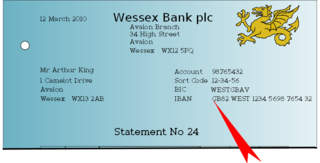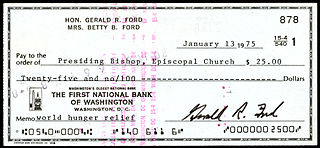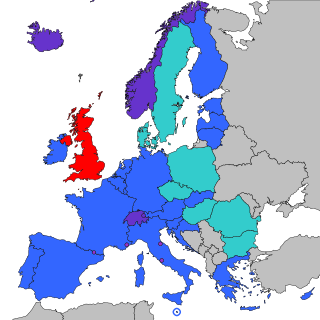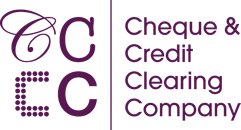List of sort codes of the United Kingdom
This article needs additional citations for verification .(July 2010) |
In the United Kingdom the initial digits of bank sort codes were originally allocated to settlement members of the Cheque and Credit Clearing Company and the Belfast Bankers' Clearing Company. Today, sort codes are issued to any organisation that will be a direct member of a UK electronic payment network (in addition to the cheque clearing systems, this includes BACS, Faster Payments and CHAPS). Non-standard sort codes are issued to payment service providers who need an IBAN, for example for SEPA, as the sort code forms part of this.
The allocation of sort codes is managed by BACS. These numbers are six digits long, formatted into three pairs which are separated by hyphens.
Cheque clearing
The cheque clearing system in the United Kingdom is managed by Pay.UK, following the merger of the Cheque and Credit Clearing Company, BACS and Faster Payments Ltd in 2018. Since August 2019, sterling cheque clearing has been through the Image Clearing System.
England and Wales
In the following list the dates in parentheses give the year of merger with the present-day sort code holder, or its subsidiary.
| Range | Bank | Note |
|---|---|---|
00 | For IBAN use only [4] | |
04 | "Utility bank" | Issued to new participants in the BACS, CHAPS and Faster Payments schemes; not usable for cheques [4] |
04-00-02 | BFC Bank | |
04-00-03 to 04-00-08 | Monzo | |
04-00-11 | Satabank | |
04-00-40 | Starling Bank | |
04-00-53 | Payrnet/Railsbank | |
04-00-72 to 04-00-74 | Modulr | |
04-00-75 and 04-29-09 | Revolut | |
04-00-76 | LCH Limited | |
04-00-78 | Elavon Financial Services | |
04-00-79 to 04-00-80 | Virgin Money Head Office | |
04-03-00 to 04-03-29 | LHV Pank | |
04-03-33 | Mettle by NatWest | |
04-04-05 | ClearBank | |
04-04-76 to 04-04-77 | Enumis | |
04-05-40 to 04-05-41 | BCB Group | |
04-06-05 | Tide (financial service) by ClearBank | |
04-13-01 | Midpoint & Transfer | |
04-13-02 to 04-13-03 | Bilderlings Pay | |
04-13-04 to 04-13-05 | Ecology Building Society | |
04-13-06 | Allpay Limited | |
04-13-07 to 04-13-08 | Clear Junction | |
04-13-12 | Modulr | |
04-13-13 to 04-13-14 | Project Imagine | |
04-13-15 to 04-13-16 | Universal Securities & Investment | |
04-13-17 to 04-13-19 | Contis Financial Services | |
04-13-42 | Duesday | |
04-29-09 | Revolut | |
04-36-14 to 04-36-23 | Griffin Bank |
| Range | Bank | Note |
|---|---|---|
01 | NatWest | Formerly District Bank (1962) |
05 | Clydesdale Bank | Trading as Yorkshire Bank |
07-00 to 07-49 | Nationwide Building Society | |
08 | The Co-operative Bank | |
08-60 to 08-61 | For building societies [nb 1] 08-60-64 for Virgin Money (ex Northern Rock accounts) | |
08-90 to 08-99 | ||
08-30 to 08-39 | Citibank | 08-31 to 08-32 for UK Government banking (NS&I, HMRC etc.) |
09-00 to 09-19 | Santander UK | Formerly Abbey National (2010) |
| ||
10-00 to 10-79 | Bank of England | Previously used for government banking and BoE employee accounts [5] |
11 | Bank of Scotland | For Halifax (since 1990), earlier used by Martins Bank (1962-1969) |
12-00 to 12-69 | For Sainsbury's Bank | |
13 | Barclays | |
14 | ||
15 | Royal Bank of Scotland | Formerly Williams & Glyn's Bank (1985), itself formerly Glyn, Mills & Company (1970) |
15-80 | For Child & Company private bank, part of The Royal Bank of Scotland (1923) | |
15-98 to 15-99 | For C. Hoare & Co, independent private bank | |
16 | Royal Bank of Scotland | Formerly Williams & Glyn's Bank (1985), itself formerly Williams Deacon's Bank (1970)
|
17 | Formerly Williams & Glyn's Bank (1985), itself formerly The National Bank (1970) | |
18 | For Coutts, a subsidiary of NatWest (1920) | |
19 | ||
20 to 29 | Barclays |
|
30 to 39 | Lloyds Bank and TSB | Formerly Lloyds TSB (2013) and earlier for Lloyds Bank (1995)
|
40 to 49 | HSBC Bank | Formerly Midland Bank (1992)
|
50 to 59 | NatWest | Formerly National Provincial Bank (1968) |
60 to 66 | Formerly Westminster Bank (1968)
| |
70 | Used by various international banks for their UK business: no longer issued. [4] | Banks including the Bank of Baroda, the National Bank of Pakistan as well as Close Brothers Group and Bank Hapoalim |
71 | Bank of England | National Savings Bank |
72 [nb 1] | Santander UK | Formerly Alliance & Leicester (2010), itself formerly Girobank (1985) |
77-00 to 77-44 | Lloyds Bank and TSB | Formerly Lloyds TSB (2013) and earlier for Trustee Savings Bank (1995) |
77-46 to 77-99 | ||
Scotland
Separately operated by the Committee of Scottish Clearing Bankers until 1985.
| Range | Bank | Note |
|---|---|---|
80 to 81 | Bank of Scotland | |
82 | Clydesdale Bank | |
83 | Royal Bank of Scotland | formerly National Commercial Bank of Scotland (1969), formerly Commercial Bank of Scotland (1959) |
84 | formerly National Commercial Bank of Scotland (1969), formerly National Bank of Scotland (1959) | |
86 | ||
87 | TSB | formerly Lloyds TSB Scotland (2013) formerly TSB Scotland (1995) |
89-00 to 89-29 | Santander UK | formerly Alliance & Leicester (2010) formerly Girobank (2003) |
Northern Ireland
The clearing system in Northern Ireland was operated under the Belfast Clearing Rules which were agreed by the Belfast Bankers' Clearing Company (formerly the Belfast Bankers' Clearing Committee), until the introduction of the Image Clearing System managed by Pay.UK which was completed in August 2019. [6] Sort codes in the 90 range are managed by the Irish Payment Services Organisation (IPSO).
| Range | Bank | Note |
|---|---|---|
90 | Bank of Ireland | |
91 | Northern Bank | trading as Danske Bank since 2012 formerly Belfast Bank (1970) |
93 | Allied Irish Banks (UK) | for AIB (Northern Ireland) formerly First Trust Bank formerly TSB Northern Ireland (1991) |
94 | Bank of Ireland | |
95 | Northern Bank | trading as Danske Bank since 2012 former Midland Bank subsidiary (1965) |
98 | Ulster Bank | subsidiary of NatWest (1917) |





